| Dodge Grand Caravan | |
|---|---|
 2011 Dodge Grand Caravan Mainstreet 2011 Dodge Grand Caravan Mainstreet | |
| Overview | |
| Manufacturer |
|
| Production | November 2, 1983 –August 21, 2020 |
| Model years | 1984–2020 |
| Assembly |
|
| Body and chassis | |
| Class | Minivan |
| Layout | |
| Related | |
| Chronology | |
| Successor |
|
The Dodge Caravan is a series of minivans manufactured by Chrysler from the 1984 through 2020 model years. The Dodge version of the Chrysler minivans, was marketed as both a passenger van and a cargo van (the only version of the model line offered in the latter configuration). For 1987, the model line was joined by the long-wheelbase Dodge Grand Caravan. Produced in five generations across 36 model years, the Dodge Caravan is the second longest-lived Dodge nameplate (exceeded only by the Dodge Charger). Initially marketed as the Dodge counterpart of the Plymouth Voyager, the Caravan was later slotted between the Voyager and the Chrysler Town & Country. Following the demise of Plymouth, the model line became the lowest-price Chrysler minivan, ultimately slotted below the Chrysler Pacifica.
Sold primarily in the United States and Canada, the Dodge Caravan was also marketed in Europe and other international markets under the Chrysler brand (as the Chrysler Voyager or Chrysler Caravan). From 2008 onward, Dodge marketed the model line only as the Grand Caravan; Ram Trucks sold a cargo-only version of the model line as the Ram C/V Tradesman. The model line was also rebranded as the Volkswagen Routan from 2009 through 2014.
After the 2020 model year, the Dodge Grand Caravan was discontinued, ending production on August 21, 2020. For 2021 production, the Grand Caravan nameplate was moved to Chrysler, which used it for a Canadian-market version of the Chrysler Pacifica (in the United States, the exact vehicle was marketed as the Chrysler Voyager).
For its entire production run, the Dodge Caravan/Grand Caravan was manufactured by Chrysler Canada (now Stellantis Canada) at its Windsor Assembly facility (Windsor, Ontario). From 1987 until 2007, the model line was also manufactured by Chrysler at its Saint Louis Assembly facility (Fenton, Missouri). Since their introduction in late 1983, over 14.6 million Chrysler minivans have been sold worldwide (including export versions and versions sold through rebranding).
Background
At the end of 1977, Chrysler commenced development on what would become the Chrysler minivans. Alongside the ability to park within a standard-height garage, designers sought to develop a vehicle with a low floor and car-like NVH levels. While front-wheel drive was sought out for the design, rear-wheel drive was still considered an alternative for cost reasons. Following the move of both Hal Sperlich and Lee Iacocca from Ford to Chrysler in late 1978, the Chrysler minivan design (codenamed T-115 at the time) adopted front-wheel drive.
While the Dodge Caravan (and Plymouth Voyager) shared no chassis underpinnings with the K-cars, the two model lines retained mechanical commonality, sharing engines and transmissions.
First generation (1984–1990)
Main article: Chrysler minivans (S) Motor vehicle| First generation | |
|---|---|
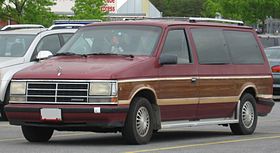 | |
| Overview | |
| Also called | Dodge Grand Caravan (LWB Model) Dodge Caravan (SWB Model) |
| Production | October 1983–1990 |
| Model years | 1984–1990 |
| Designer | Bob Hubbach (1980) |
| Body and chassis | |
| Body style | 3-door minivan |
| Layout | Transverse front-engine, front-wheel drive |
| Platform | Chrysler S platform |
| Related | Chrysler Town & Country Plymouth Voyager Dodge Mini Ram Chrysler Voyager (Europe only) |
| Powertrain | |
| Engine |
|
| Transmission | 4-speed A460 manual 5-speed manual 3-speed A413 automatic 3-speed A470 automatic 3-speed A670 automatic 4-speed A604 automatic |
| Dimensions | |
| Wheelbase | 1984–1988 SWB: 112.1 in (2,847 mm) Grand Caravan & C/V Extended: 119.1 in (3,025 mm) 1989–1990 SWB & C/V: 112 in (2,844.8 mm) |
| Length | SWB & C/V: 175.9 in (4,468 mm) Grand Caravan: 190.5 in (4,839 mm) 1989–1990 LE SWB: 177.3 in (4,503 mm) 1989–1990 Grand Caravan LE: 191.9 in (4,874 mm) C/V Extended: 190.6 in (4,841 mm) |
| Width | 1984–1988: 69.5 in (1,765 mm) 1989–1990: 72 in (1,829 mm) |
| Height | 1984–1988 SWB: 64.4 in (1,636 mm) 1987–1988 Grand Caravan: 65 in (1,651 mm) C/V: 64.2 in (1,631 mm) 1989–1990 SWB: 64.6 in (1,641 mm) 1989–1990 Grand Caravan: 64.8 in (1,646 mm) |
Initially slated for introduction as a 1982 model, the Dodge Caravan was introduced alongside the Plymouth Voyager in November 1983 for the 1984 model year.
Interior trim, controls, and instrumentation were borrowed from the Chrysler K platform, and with the lower floor made possible by the front-wheel-drive platform, the Caravan featured car-like ease of entry. Three trim levels were available: base, SE, and LE. The Caravan, along with the Plymouth Voyager, are considered to be the first mass-produced vehicles to have dedicated built-in cup holders.
Base models came equipped for five passengers in two rows of seating. The LE came with seven passengers standard in three rows of seating. The base van had two bucket seats with attached armrests and open floor space between them in the front and a three-person bench seat in the second row. The seven-passenger included two bucket seats with attached armrests and open floor space between them in the front, a two-person bench seat in the second row, and a three-person bench seat in the back row. The two bench seats in the rear were independently removable, and the large three-person bench could also be installed in the second-row location via a second set of attachment points on the van's floor, ordinarily hidden with snap-in plastic covers. This configuration allowed for conventional five-person seating with a sizable cargo area in the rear. The latching mechanisms for the benches were easy to operate, although removing and replacing the seats typically required two adults. A front low-back 60/40 split-bench, accommodating a third front passenger in the middle, was offered exclusively in the SE trim level for 1985, allowing for a maximum of eight passengers. This configuration was subsequently discontinued. The base model's curb weight was 2,910 lb (1,320 kg).
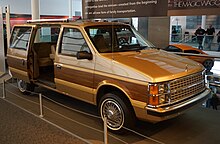
Safety features included three-point seat belts for the front two passengers and lap belts for the rear five. The seats on base models and cloth-trimmed SEs had no headrests due to the vehicle's "light truck" classification rather than following standard passenger car safety standards. However, the two front seats included non-adjustable headrests on the LE model and in conjunction with vinyl upholstery on the SE versions. Safety standards mandated side-impact reinforcements at all seating positions, front and rear.
Access to the rear rows of seating was by a large passenger-side sliding door, enabling easy access in confined situations, e.g., parking. Because only one sliding door was offered, the smaller second-row bench seat was shifted to the driver's side of the van, facilitating passenger access to the third-row seat. To facilitate variable cargo storage behind the third-row rear seat, the seat could be adjusted forward in two increments, the first of which reduced legroom for the back row passengers by about 6 inches (150 mm), and the second of which would push the bench to the back of the second row, making the seats unusable. The seatback of the rear bench could also be folded forward, providing a flat cargo shelf. The narrower second-row bench was neither adjustable nor foldable; it could only be removed entirely.
Cargo access to the rear was via a hatchback, similar to the one on the K platform station wagons. The hatch was hinged at the top and held open by gas struts.
A long-wheelbase variant, marketed as the Grand Caravan, was introduced in May 1987. It offered more cargo space behind the third-row seat.
A commercial cargo version of the Caravan, called the Mini Ram Van, was also introduced for 1984, with a flat-floored cargo space offering a four-foot interior height and featuring four feet of space between the rear wheel wells. The load capacity was 1,700 lb (770 kg). It was renamed the Caravan C/V for 1989 and was discontinued after 1995. It was initially available with a short wheelbase; a long-wheelbase variant was introduced alongside the Grand Caravan.
Unique to the Caravan C/V was a traditional hatch door in the back or the optional swing-out bi-parting doors (with or without windows), similar to those of more traditional cargo vans. These doors were made of fiberglass. Also based on the Mini Ram and C/V were aftermarket conversion vans sold through official Chrysler dealers and from the conversion companies themselves.
Trim levels
- Base – Included: Vinyl upholstery, 5-passenger seating, warning chimes, cigar lighter, digital clock, manual locks, windows and mirrors, 15-gallon fuel tank, tinted windows, halogen headlamps, an AM/FM stereo with four speakers, vinyl steering wheel, and intermittent wipers.
- SE – Added: Cloth upholstery, reclining front seats, rear assist strap, 20-gallon fuel tank, power liftgate release, tape stripes, and steel road wheels.
- LE – Added: Cloth-and-vinyl upholstery, front and rear fascia, forward storage console, warning lights for door ajar, storage drawer, washer fluid warning, and power mirrors.
Transmissions

Both a 3-speed TorqueFlite automatic transmission and a 5-speed manual were available with all straight-four engines, including the turbocharged 2.5-liter (this was a rare combination). The Plymouth Voyager, which was a rebadged version of the Caravan, was also available with a manual transmission. The Chrysler Town & Country, released in 1990, was a more luxurious repackaged version of the Caravan and had no manual transmission option. Manual transmissions were not available on V6 models of the passenger Caravan, but were an option on the Mini Ram Van and Caravan C/V's long-wheelbase models with a 3.0 L V6.
The V6 engines were only offered with the venerable fully hydraulically operated TorqueFlite, until the computer-controlled Ultradrive 4-speed automatic became available in 1989. The Ultradrive offered better fuel economy and responsiveness, particularly when paired with the inline-four engine. However, it suffered from reliability problems, usually stemming from what is known as "gear hunt" or "shift busyness", resulting in premature wear of the internal clutches. It also required an uncommon type of automatic transmission fluid and is not clearly labeled as such, leading many owners to use the more common Dexron II rather than the specified "Mopar ATF+3", resulting in transmission damage and eventual failure. Early model transmissions would eventually be retrofitted or replaced with the updated versions by dealers under warranty.
Engines
For the first three years of production, two engines were offered in the Caravan – both straight-four engines with 2-barrel carburetors. The base 2.2 L was borrowed from the Chrysler K-cars, and produced 96 hp (72 kW) horsepower. The higher performance fuel-injected version of the 2.2 L engine later offered in the K-cars was never offered in the Caravan, and the 2-bbl version would remain the base power plant until mid-1987. Alongside the 2.2 L, an optional Mitsubishi 2.6 L engine was available, producing 104 hp (78 kW) horsepower.
In mid-1987, the base 2.2 L I4 was replaced with a fuel-injected 2.5 L I4, which produced 100 hp (75 kW), while the Mitsubishi G54B I4 was replaced with the new fuel-injected 3.0 L Mitsubishi V6 producing 136 hp (101 kW) in March of that year.
Shortly thereafter in model year 1989, a more powerful engine became optional, with a turbocharged version of the base 2.5 L producing 150 hp (112 kW). Revisions to the Mitsubishi V6 upped its output to 142 hp (106 kW) that same year, and in 1990 a new 150 hp (110 kW) 3.3 L V6 was added to the option list. The V6 engines became popular as sales of the 2.5 L turbo dwindled and it was dropped at the end of the year. In these years, the ES model debuted (short-wheelbase only) to highlight the new engines, the turbo 2.5 L in particular. The ES was introduced to the long-wheelbase Grand Caravan for 1991 and continued throughout 2003 before it was discontinued and replaced with the SXT.
- 1984–1987 2.2 L K I4, 96 hp (72 kW), 119 lb⋅ft (161 N⋅m)
- 1984–1987 2.6 L Mitsubishi G54B I4, 104 hp (78 kW), 142 lb⋅ft (193 N⋅m)
- 1987½–1990 2.5 L K I4, 100 hp (75 kW), 135 lb⋅ft (183 N⋅m)
- 1987½–1988 3.0 L Mitsubishi 6G72 V6, 136 hp (101 kW), 168 lb⋅ft (228 N⋅m)
- 1989–1990 2.5 L K Turbo I4, 150 hp (110 kW), 180 lb⋅ft (240 N⋅m)
- 1989–1990 3.0 L Mitsubishi 6G72 V6, 142 hp (106 kW), 173 lb⋅ft (235 N⋅m)
- 1990 3.3 L EGA V6, 150 hp (110 kW), 185 lb⋅ft (251 N⋅m)
Second generation (1991–1995)
Main article: Chrysler minivan (AS) Motor vehicle| Second generation | |
|---|---|
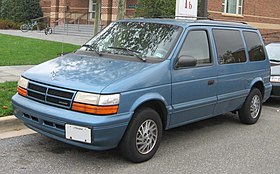 | |
| Overview | |
| Also called | Dodge Grand Caravan (LWB Model) Dodge Caravan (SWB Model) Guangdong Sanxing SXZ6451 (Short wheelbase)/SXZ6490 (Long wheelbase) (China) |
| Production | August 14, 1990 – August 1995 |
| Model years | 1991–1995 |
| Designer | Bob Hubbach (1987) |
| Body and chassis | |
| Body style | 3-door minivan |
| Layout | Transverse front-engine, front-wheel drive / all-wheel drive |
| Platform | Chrysler AS platform |
| Related | Chrysler Town & Country Plymouth Voyager Chrysler Voyager (Europe only) |
| Powertrain | |
| Engine | |
| Transmission | 5-speed A523 manual 3-speed A670 3-speed A413 automatic 4-speed A604 automatic |
| Dimensions | |
| Wheelbase | 1991–1993 C/V: 112 in (2,845 mm) SWB & 1994–1995 C/V: 112.3 in (2,852 mm) 1991–1993 C/V Extended: 119.1 in (3,025 mm) C/V AWD: 112 in (2,845 mm) Grand Caravan & 1994–1995 C/V Extended: 119.3 in (3,030 mm) |
| Length | 1991–1993 C/V: 175.9 in (4,468 mm) 1991–1993 SWB & 1994–95 C/V: 178.1 in (4,524 mm) 1991–1993 C/V Extended: 190.6 in (4,841 mm) Grand Caravan: 192.8 in (4,897 mm) |
| Width | 72 in (1,828.8 mm) 1991 C/V: 72.2 in (1,834 mm) 1992–1993 C/V: 69.6 in (1,768 mm) |
| Height | SWB & 1991–93 C/V: 64.2 in (1,631 mm) Grand Caravan: 64.8 in (1,646 mm) 1991–93 AWD: 65.9 in (1,674 mm) Grand Caravan: 66 in (1,676.4 mm) Grand Caravan: 66.7 in (1,694 mm) 1994–95 SE: 64.3 in (1,633 mm) |
| Curb weight | 3,305 lb (1,499 kg) 3,531 lb (1,602 kg) (Grand Caravan) |
For the 1991 model year, the second-generation Dodge Caravan was released. Intended as an extensive revision of the first generation, while the chassis underpinnings were carried over and updated, the only shared body panels were the front doors and the sliding door. To match the Ford Aerostar and General Motors APV minivans, designers sought to improve the exterior aerodynamics and the handling of the model line. To enhance safety, anti-lock brakes and all-wheel drive were introduced as options; as a first in the segment, a driver-side airbag became an option in 1991 (a first in the segment).
The model line again came in two lengths, with the long-wheelbase Grand Caravan making its return; the C/V cargo van also was part of the model line. The Caravan was further distinguished from the Voyager; along with different grilles and headlamp units, the Caravan received less chrome trim (limited to the grille and the Chrysler Pentastar hood ornament). Shedding its connection to the K-cars, the Caravan received a unique dashboard design (though shared with the Voyager, the Caravan received a new steering wheel design). On all but the base-trim Caravan, the seven-passenger trim was standard. In addition to the two rear bench seats, the second generation introduced the option of middle-row bucket seats; in 1992, Chrysler introduced integrated child safety seats, an innovation in the segment.
For the 1994 model year, the Caravan underwent a mid-cycle revision as part of a body upgrade to meet 1998 federal safety standards. Though the exterior saw only minor changes to the bumpers and lower body side trim, the interior underwent larger changes, receiving new seats and door panels. Coinciding with the addition of a passenger-side airbag, the dashboard was redesigned. Following its declining popularity, the woodgrain trim option was discontinued in favor of monochromatic and two-tone exterior designs.
To commemorate the tenth year of production, Dodge offered the "10th Anniversary Edition" option package for 1994. Available on SE/LE trims of the Caravan and Grand Caravan, the 10th Anniversary Edition was an appearance package, combining a two-tone exterior (a light-gray lower body with selected upper body colors) with a gold front fender badge.
Trim levels
- Base – Included: cloth-and-vinyl upholstery, intermediate bench seat, tinted manual windows, power mirrors, intermittent windshield wipers and a rear wiper, glove box, and an AM/FM stereo.
- SE – Added: power liftgate release, reclining front seats, and a rear bench seat.
- LE – Added: heated mirrors, forward storage console, tachometer, oil pressure, and voltage gauges, an overhead console, power locks, rear defroster, speed control, storage drawer under the front passenger seat, and a tilt steering column.
Engines
Except for the discontinued 150 hp 2.5 L turbocharged I4, the second-generation Caravan carried over its powertrain line from the 1990 Dodge Caravan. Shifting its powertrain commonality from the Dodge Aries to that of the larger Dodge Dynasty, a 2.5 L I4 was the standard engine, with a 3.0 L V6 and 3.3 L V6 as options. In 1994, the Caravan received a 3.8 L V6 (shared with the Chrysler Imperial/Fifth Avenue) as an option.
- 1991–1995 2.5 L EDM (K) I4, 100 hp (75 kW), 135 lb⋅ft (183 N⋅m)
- 1991–1995 3.0 L Mitsubishi 6G72 V6, 142 hp (106 kW), 173 lb⋅ft (235 N⋅m)
- 1991–1993 3.3 L EGA V6, 150 hp (110 kW), 185 lb⋅ft (251 N⋅m)
- 1994–1995 3.3 L EGA V6, 162 hp (121 kW), 194 lb⋅ft (263 N⋅m)
- 1994–1995 3.8 L EGH V6, 162 hp (121 kW), 213 lb⋅ft (289 N⋅m)

Integrated child safety seats
In 1991, Dodge introduced a second-row bench seat integrating two child booster seats on 1992 models. These seats continued as an available option through Generation V until they were discontinued in 2010.
Third generation (1996–2000)
Main article: Chrysler minivans (NS) Motor vehicle| Third generation | |
|---|---|
 Dodge Grand Caravan Sport Dodge Grand Caravan Sport | |
| Overview | |
| Also called | Dodge Grand Caravan (LWB Model) Dodge Caravan (SWB Model) 3-Star Grand Caravan SXZ6510 (China) |
| Production | January 30, 1995–2000 |
| Model years | 1996–2000 1996–2002 (China) |
| Assembly | St. Louis, Missouri, U.S. Windsor, Ontario, Canada |
| Designer | Don Renkert (1991) |
| Body and chassis | |
| Body style | 3-door and 4-door minivan |
| Layout | Transverse front-engine, front-wheel drive / all-wheel drive |
| Platform | Chrysler NS platform |
| Related | Chrysler Town & Country Plymouth Voyager Chrysler Voyager |
| Powertrain | |
| Engine | |
| Transmission | 5-speed manual (diesel) 3-speed 31TH automatic 3-speed A670 automatic 4-speed 41TE automatic |
| Dimensions | |
| Wheelbase | SWB: 113.3 in (2,878 mm) Grand Caravan: 119.3 in (3,030 mm) |
| Length | SWB: 186.3 in (4,732 mm) Grand Caravan FWD: 199.6 in (5,070 mm) Grand Caravan AWD: 199.7 in (5,072 mm) |
| Width | 76.8 in (1,951 mm) |
| Height | 68.5 in (1,740 mm) FWD: 68.7 in (1,745 mm) |
| Curb weight | 3,528 lb (1,600 kg) 3,680 lb (1,669 kg) (Grand Caravan) |
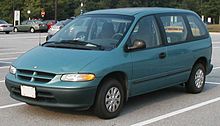

The third-generation Chrysler minivans were available in long- and short–wheelbase models; three- and four-door configurations; and eight different powertrains, including electric and compressed natural gas; on a single, flexible platform.
In development for nearly 5 years from early 1990 (full development from 1991) to December 26, 1994 (final design by Don Renkert was approved on September 23, 1991, and frozen in May 1992), the 1996 model was introduced at the 1995 North American International Auto Show using the Chrysler S platform. It included a number of innovations, including a driver's side sliding door (optional initially, to become standard equipment later), a first for Chrysler and a non-compact minivan for the United States and Canada. With Generation III, Chrysler introduced a seat management system marketed as Easy Out Roller Seats. A conventional door handle and lock were added to the rear hatch, eliminating the confusing pop-and-lift maneuver that had been required on earlier models.
Base models of the Caravan were offered in most states with either a 2.4 L four-cylinder or the 3.0 L Mitsubishi 6G72 V6 engine, except in several northeastern states, where the Mitsubishi did not meet emissions standards. In those areas, the 3.3 L engine was offered as the V6 option from 1997 through 2000.
The 1996 Caravan, along with the Plymouth Voyager and the Chrysler Town & Country won the North American Car of the Year award. The Caravan itself won Motor Trend magazine's Car of the Year 1996 and appeared on the Car and Driver Ten Best for 1996 and 1997. 1999 also saw the addition of a one-year-only 15th anniversary "Platinum Edition", to mark Caravan's 15th year of production. This package was offered on various trim levels and included Platinum Metallic paint as well as fender badges. The 2000 model year offered packages that included the "2000+" and "Millennium" packages; however, these were little more than unique fender badges on the vans with popular equipment.
During the 1996 model year, running changes saw the elimination of the plastic intake manifold cover from the 3.8L engine and redesigned interior door panels. Changes for the 1997 model year were minor, adding traction control as an option or standard equipment, depending on trim level, along with the reintroduction of optional all-wheel drive. The Caravan received more minor updates in 1997 for the 1998 model year. These changes came in the form of new colors, new wheels for trims above SE, new interior fabric, optional heated seats, and automatic headlights on higher trim levels. In the calendar year 1998, the Caravan's HVAC vents on the driver's side and center of the dashboard were updated to have a more conventional design. Later that year, the 1999 Caravan received new front styling on all trims above SE, while the Sport and ES models received even sportier styling. The ES model was the first minivan to receive the "AutoStick" transmission and 17-inch wheels. A cargo net between the driver and front passenger seats was added. Color-keyed door and lift-gate handles were made standard on SE models, in addition to a new keyless entry remote. Base and SE models had options for a spoiler as well as color-keyed bumpers and trim (grey or color-molded bumpers and trim were standard). The driver's side sliding door became standard. Chrysler had updates of the Plymouth Voyager in 1996 for the 1997 model year and the Chrysler Town & Country in 1997 for the 1998 model year, before the 1998–2007 DaimlerChrysler era; it was the only exterior update of the NS Dodge Caravan.
Trim levels
- Base – Included: Cloth upholstery, speed-sensitive wipers, manual locks, 14-inch steel road wheels with "Successor" hubcaps, and an AM/FM stereo with four speakers. Package 22T added air conditioning and a cargo net.
- SE – Added: air conditioning, power mirrors, speed control, rear defroster, power locks, sliding rear driver's side door, an AM/FM stereo with cassette player and four speakers, steering wheel audio controls, and 15-inch steel road wheels with "revolver" hubcaps. Package 28D added power front windows with automatic driver's side window, ignition delay, glove box, and an ashtray.
- Sport – Added: tinted windows, and power windows with automatic driver's side window, fog lamps, and 16-inch steel road wheels with "Vortex" hubcaps.
- LE – Added: optional leather seating surfaces, dual-zone air conditioning with temp control, overhead console with sunglass holder, garage door opener holder, illuminated entry, headlamp off delay, keyless entry, security alarm, power driver's seat, an AM/FM stereo with cassette player, steering wheel audio controls, graphic equalizer, Infinity 200-watt sound system and 10 speakers, center console storage bin, and 15-inch steel road wheels with "Citadel" hubcaps.
- ES – Added: leather seating surfaces, fog lamps, automatic headlamps, garage door opener, heated power front seats, an AM/FM stereo with cassette and CD players, rear spoiler, and 16-inch "genesis" alloy road wheels.
Engines
- 1996–2000 2.4 L EDZ I4, 150 hp (110 kW), 167 lb⋅ft (226 N⋅m) (Canadian vans beginning in 1999 included a 3.0 L V6 as standard equipment)
- 1996–2000 3.0 L Mitsubishi 6G72 V6 150 hp (110 kW), 176 lb⋅ft (239 N⋅m) (not available in certain U.S. states, 3.3 L V6 offered as standard equipment in those states instead)
- 1996–2000 3.3 L EGA V6, 158 hp (118 kW), 203 lb⋅ft (275 N⋅m)
- 1996–1997 3.8 L EGH V6, 166 hp (124 kW), 227 lb⋅ft (308 N⋅m)
- 1998–2000 3.8 L EGH V6, 180 hp (130 kW), 240 lb⋅ft (330 N⋅m)
Dodge Caravan EPIC
Main article: Dodge EPICIn 1999, Dodge introduced the Caravan EPIC, a fully electric minivan. The EPIC was powered by 28 12-volt NiMH batteries and was capable of traveling up to 80 miles (130 km) on a single charge. The EPIC was a fleet-only lease vehicle. Production of the EPIC was discontinued in 2001. Only a few hundred of these vehicles were produced. After the leases expired they were returned and crushed. Approximately ten vans remain in private hands today.
Crash test results
The 1996–2000 Dodge Grand Caravan received a "Marginal" rating in the Insurance Institute for Highway Safety's 40 mph offset test. The structural performance and restraints were graded "Acceptable", but the foot injuries were very high.
In the NHTSA crash tests, it received 4 stars for the driver and front passenger in the frontal impact. In the side-impact test, it received 5 stars for the driver, and 3 stars for the rear occupant, and resulted in a fuel leak that could cause a fire hazard.
Concepts
Other plans for this generation included three minivan concepts to be made in the Windsor Assembly, the Dodge Caravan R/T, Voyager XG, and the Chrysler Pacifica 1999 concept. The Caravan R/T (originally ESS) was to include the most powerful engine ever for a minivan, rated at 325 horsepower (242 kW). It had large air intakes and driving lights in the front bumper, a brushed aluminum instrument panel, racing-style pedals, and black and white rubber flooring. The Voyager XG was more rugged, featured a diesel engine and manual transmission, and included many outdoor amenities, such as a built-in ice pack. The Chrysler Pacifica, based on the Town & Country, was more luxurious, had power leather seats and footrests, overhead bins, lighting, an LHS grille, and roof-long skylights. The Pacifica was not introduced in 2004, based on the fifth-generation Caravan, except that it became a crossover SUV rather than a minivan; the nameplate was eventually applied to a minivan in 2016.
Easy-Out Roller Seats
In 1995, Dodge introduced a system of seats to simplify installation, removal, and re-positioning, marketed as Easy-Out Roller Seats. When installed, the seats are latched to floor-mounted strikers. When unlatched, eight rollers lift each seat, allowing it to be rolled fore and aft. Tracks have locator depressions for rollers, to simplify installation. Ergonomic levers at the seatbacks release the floor latches single-handedly, without tools, and raise the seats onto the rollers in a single motion. Additionally, seatbacks were designed to fold forward. Seat roller tracks are permanently attached to the floor and seat stanchions are aligned, facilitating the longitudinal rolling of the seats. Bench seat stanchions were moved inboard to reduce bending stress in the seat frames, allowing them to be lighter.
When configured as two and three-person benches (available through Generation IV), the Easy Out Roller Seats could be unwieldy. Beginning in 2000, second and third-row seats became available in a 'quad' configuration – bucket or captain chairs in the second row and a third-row three-person 50/50 split "bench" – with each section weighing under 50 lb (23 kg). The Easy-out system remained in use through Generation V – where certain models featured a two-person bench and the under-floor compartments from the Stow'n Go system.
All the rebadged nameplate variants of the Chrysler minivans use the Easy Out Roller Seats on their second-row seating, whereas not the Stow and Go system.
Fourth generation (2001–2007)
Main article: Chrysler minivans (RS) Motor vehicle| Fourth generation | |
|---|---|
 2007 Dodge Caravan Base (post-facelift) 2007 Dodge Caravan Base (post-facelift) | |
| Overview | |
| Also called | Dodge Grand Caravan (LWB Model) Dodge Caravan (SWB Model) |
| Production | July 24, 2000 – July 2007 (North America) 2007–2011 (China) |
| Model years | 2001–2007 (North America) 2008–2012 (China) |
| Designer | Brandon Faurote (1997) |
| Body and chassis | |
| Body style | 4-door minivan |
| Layout | Transverse front-engine, front-wheel drive / all-wheel drive |
| Platform | Chrysler RS platform |
| Related | Chrysler Town & Country Chrysler Pacifica Chrysler Voyager |
| Powertrain | |
| Engine | 2.4 L EDZ I4 2.8 L CRD diesel (Philippines) 3.0 L 6G72 V6 (China) 3.3 L EGA V6 3.8 L EGH V6 |
| Transmission | 3-speed 31TH automatic with 2.4EDZ 4-speed 41TE automatic |
| Dimensions | |
| Wheelbase | SWB: 113.3 in (2,878 mm) Grand Caravan: 119.3 in (3,030 mm) |
| Length | 2001–2004 SWB: 189.1 in (4,803 mm) 2005–2007 SWB: 189.3 in (4,808 mm) Grand Caravan: 200.5 in (5,093 mm)/200.6 in (5,095 mm) |
| Width | 78.6 in (1,996 mm) |
| Height | 68.9 in (1,750 mm) |
| Curb weight | 3,862 lb (1,751 kg)
3,999 lb (1,813 kg) (Grand Caravan) |
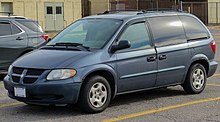

Unveiled at the 2000 North American International Auto Show (NAIAS) on Monday, January 10, 2000, the redesigned 2001 Dodge Caravan and 2001 Chrysler Town & Country were released for sale in August 2000. The release was part of a promotional tie-in with Nabisco, which unveiled their new "Mini Oreos" inside the van during the unveiling. The first vans rolled off the line at the Windsor Assembly Plant on July 24. The fourth generation vans were available in the trim levels; SE, Sport, SXT, AWD Sports, "base" model, AWD Choice, eL, C/V, ES, EX, AWD Wagon, and SXT All-Wheel-Drive.
In development from February 1996 to December 1999, the Generation IV minivans were based on the Chrysler RS platform and featured a larger body frame with modified headlights and taillights. Design work was done by Brandon Faurote in January 1997 and reached production approval in 1998.
In addition to other detailed changes, power sliding doors and a power hatch became available as options. The Mitsubishi 3.0 L V6, which no longer met emissions standards in California and the northeastern U.S., was discontinued, and a more powerful 3.8 L engine, based on the 3.3 L, became available. All All-wheel drive continued to be offered on high-end models. Other innovative available features included remote-operated sliding doors and a rear hatch, which could be opened and closed at the push of a button, either inside the vehicle or with the keyless entry fob.
In the 2002 model year, DaimlerChrysler stopped using the "DODGE" badges on the front doors, like with all Dodge vehicles.
In 2003, the Caravan C/V and Grand Caravan C/V returned after having been discontinued in 1995. The C/V featured the option of deleted side windows (replaced by composite panels), optional rear seats, a cargo floor made of plastic material similar to pickup truck bed liners, rubber flooring in place of carpeting, and a normal hatch at the rear. Minor changes were made to the Grand Caravan ES including many of the features included in Option Group 29S becoming standard, the 17-inch Titan chrome wheels no longer being an option replaced with standard 16-inch chrome wheels, and the disappearance of the AutoStick Transmission option. This year also saw the appearance of an optional factory-installed rear-seat DVD system with a single-disc player mounted below the HVAC controls.
The 2004 model year offered an exclusive one-year-only "Anniversary Edition" package to mark Caravan's 20th year in production. This package was offered on higher-level SXT models and included chrome wheels, body-color moldings, special interior accents, as well as a unique fender badge.
The 2005 model year came very early, starting production in January 2004. Changes for 2005 included a revised grille, new foglight fascia, and a system of in-floor folding second and third-row seats, marketed as Stow 'n Go seating.
Production of this generation continued in China from 2008, when the Taiwanese Chrysler Town & Country production line was relocated there, until late 2010 when the fifth generation Chrysler Voyager was introduced to the Chinese market. The Caravan was subsequently replaced by the Journey, although a page for the Caravan still exists on the Dodge China site. The Chinese Caravan was produced alongside the Town & Country, now using the Grand Voyager nameplate, by Soueast, and did not share any aesthetic components with the North American Caravan aside from the wheels. Instead, the Chinese Caravan was identical to the Taiwanese Town & Country, aside from the lack of chrome trim on the exterior door panels, and used a modified version of the Town & Country front bumper with a Dodge grille. Chinese vans were equipped with Mitsubishi 6G72 engines and came in three trim levels: Classic, SXT, and Luxury.
Trim levels
- SE – Included: Cloth upholstery, grocery bag hooks, manual air conditioning, tinted windows, manual locks, an AM/FM stereo with cassette player and four speakers (later, a single-CD player replaced the tape deck), and 15" steel road wheels with "Kinetic" hubcaps. Later standard features were sliding door alert (hazards flash when opening), and 15-nch steel road wheels with "Interface" hubcaps.
- SE Plus (Grand Caravan only) – Added: power mirrors, sound insulation, keyless entry, illuminated entry, power front windows, and rear vents,
- Sport – Added: an overhead console, rear defroster, sunscreen glass, speed control, power locks, floor mats, tachometer, power heated mirrors, an AM/FM stereo with cassette player and 6 speakers, power windows, and 15-inch "crossfire" hubcaps. Package 25H added dual-zone air conditioning, glove box and ashtray lights, and headlamp off delay. Package 25K added an AM/FM stereo with single CD and cassette players and 6 speakers, power sliding doors, and a power driver's seat. Later replaced by the SXT package.
- SXT – Added (from SE Plus): Three-zone air conditioning, power driver's seat, fog lamps, power sliding doors, HomeLink garage door opener, an AM/FM stereo with single-CD/cassette players and 6 speakers, tachometer, and 16-inch "Ingot" alloy road wheels.
- ES – Added: three-zone air conditioning, a trip computer, fog lamps, driver's side power sliding door, garage door opener, an AM/FM stereo with cassette player, in-dash 4-disc CD changer with Infinity sound system, and 16-inch "Europa" alloy road wheels.
Engines
- 2001–2007 2.4 L EDZ I4, 150 hp (110 kW) at 5400 rpm and 165 lb⋅ft (224 N⋅m) at 4000 rpm
- 2001–2007 3.3 L EGA V6, 180 hp (130 kW) at 5000 rpm and 210 lb⋅ft (280 N⋅m) at 4000 rpm
- 2001–2007 3.8 L EGH V6, 200 hp (150 kW) at 5000 rpm and 245 lb⋅ft (332 N⋅m) at 4000 rpm
IIHS results
The 2001 model of this version earned a "Poor" rating in the Insurance Institute for Highway Safety's 40 mph offset test. It did protect its occupants reasonably well, and the dummy movement was well controlled, however, a fuel leak occurred. Chrysler corrected this problem starting with the 2002 models, moving it up to an "Acceptable" rating.
The 2006 model year brought optional side curtain airbags and a stronger B-pillar, which was tested by the Insurance Institute for Highway Safety's side-impact crash test. With the side airbags, it got an "Acceptable" rating. For the driver, there is a chance of serious neck injuries, rib fractures, and/or internal organ injuries. The rear passengers, however, could leave this accident unharmed, as there is a low risk of significant injury in a crash of this severity for them.
Stow 'N Go seating
In 2004, Dodge introduced a system of second- and third-row seating that folded completely into under-floor compartments. It was marketed as Stow 'N Go and was available exclusively on long-wheelbase models.
In a development program costing $400 million, engineers initially used an Erector Set to visualize the complex interaction of the design and redesigned under-floor components. The system included the spare tire well, fuel tank, exhaust system, parking brake cables, rear climate control lines, and rear suspension but precluded all-wheel drive (AWD).
The system, in turn, creates a combined volume of 12 cubic feet (340 L) of under-floor storage when second-row seats are deployed. With both rows folded, the vans have a flat-load floor and a maximum cargo volume of 160.7 cubic feet (4,550 L).
The Stow 'n Go system received the Popular Science Magazine's "Best of What's New" for 2005 award, and was never offered on the Volkswagen Routan, the rebadged nameplate variant of the Chrysler minivans.
For the model year 2011, Chrysler revised the system, rebranding it as "Super Stow 'n Go". New pivoting head restraints with taller seatbacks and a revised folding mechanism (marketed as "single action") improved stowage ease – with the head restraints folding on themselves automatically and the entire seat automatically folding down to a position just over its floor recess.
Fifth generation (2008–2020)
Main article: Chrysler minivans (RT) Motor vehicle| Fifth generation (Dodge Grand Caravan) | |
|---|---|
 2008 Dodge Grand Caravan SXT 2008 Dodge Grand Caravan SXT | |
| Overview | |
| Also called | Ram C/V Tradesman |
| Production | August 16, 2007 – August 21, 2020 |
| Model years | 2008–2020 |
| Designer | Ralph Gilles (2006) |
| Body and chassis | |
| Body style | 4-door minivan |
| Layout | Transverse front-engine, front-wheel drive |
| Platform | Chrysler RT platform |
| Related | Chrysler Town & Country Chrysler Grand Voyager Volkswagen Routan |
| Powertrain | |
| Engine | 2.8 L 176 hp (131 kW) CRD I4 diesel 3.3 L 175 hp (130 kW) V6 3.8 L 197 hp (147 kW) V6 4.0 L 251 hp (187 kW) V6 3.6 L 283 hp (211 kW) Pentastar V6 |
| Transmission | 4-speed automatic (3.3 engine) 62TE 6-speed automatic (3.6, 3.8, 4.0 engines) |
| Dimensions | |
| Wheelbase | 121.2 in (3,078 mm) |
| Length | 202.5 in (5,144 mm) Ram Cargo Van: 202.8 in (5,151 mm) |
| Width | 78.7 in (1,999 mm) |
| Height | 69.0 in (1,753 mm) |
| Curb weight | 4,306 lb (1,953 kg) |
The fifth-generation Dodge minivan debuted at the 2007 North American International Auto Show with exterior styling by Ralph Gilles. Beginning with Generation V in the model year 2008, Chrysler only made the long-wheelbase Grand Caravan. With the discontinuation of the short-wheelbase Caravan, Dodge offered the Journey on nearly an identical wheelbase and as a crossover rather than a minivan. Although the SWB model, which had accounted for half of all sales in Canada, cost approximately $2,000 less and offered a four-cylinder engine option with improved fuel economy, Chrysler executives stated the SWB Caravan was discontinued to accommodate new features offered in the Grand Caravan, consistent with the demands of the majority of the minivan market.
A new six-speed automatic transmission became standard with the 3.8 L V6 and the new 4.0 L V6. The four-speed automatic transmission is standard with the 3.3 L Flex-Fuel V6. This generation of Grand Caravan and its Town & Country counterpart were not available with an all-wheel-drive system. The previously unavailable Electronic Stability Control was made standard on this generation.
Chrysler introduced a seat management system marketed as Swivel'n Go seating, the MyGIG entertainment system (a stereo with a built-in hard drive for recording, storing, and playing music), second and third-row video screens, powered second-row windows, standard side curtain airbags, and dashboard-mounted transmission controls. The gear shift lever moved to the instrument panel, the location used by competitors.
The market shifted briefly away from minivans and SUVs with the gasoline price spikes of the earlier part of 2008. This trend began to reverse itself in the fall of 2008. During 2009 and 2010 the Dodge Grand Caravan continued to be the top-selling minivan in Canada, with over 60% of the market's monthly sales.
Automotive News reported that from January to October 2010, Dodge sold about a third of its 2010 Grand Caravans to rental fleets. The relatively high rental fleet sales depressed used vehicles' resale value: as the number of returned ex-rental 2010 Grand Caravan to the market jumped fourfold between July and October, prices of used 2009 and 2010 Dodge minivans dropped by as much as 20%.
The Dodge Grand Caravan was discontinued after the 2020 model year because of "regulatory reasons". It was reported that the cost of updating the vehicle to meet new federal safety regulations is so high that it would eliminate its low price advantage.
Trim levels
- SE – Included: Cloth upholstery, 16-inch steel wheels with hubcaps, overhead console with observation mirror, sunglass bin (not available if equipped with sunroof), power locks, power windows with automatic driver's side window, sliding door alert system (hazards flash for 10 seconds when opened), manual sliding doors, manual mirrors, air conditioning (manual temperature control), floor console, and an AM/FM stereo with a single-CD player, MP3 capability, auxiliary input jack and four speakers.
- SXT Added: power sliding doors, power heated mirrors, automatic front windows, power second-row windows, rear power vents, a rear overhead console, universal garage door opener, LED lighting with rear overhead swivel lamps, leather-wrapped steering wheel with audio controls, power driver's seat, Stow N Go, an AM/FM stereo with single-CD/DVD player with MP3 capability, 20 GB HDD, backup camera and 6 speakers, and 16-inch alloy road wheels.
- SXT Premium Added: Chromed exterior mirrors and chrome-striped side molding, 17-inch alloy road wheels, power sunroof
Engines
| Model | Displacement | Type | Valves | Power (HP@RPM) |
Torque (lb-ft@RPM) |
Compression ratio |
Transmission | Fuel economy (MPG) |
Years |
|---|---|---|---|---|---|---|---|---|---|
| 2.8L VM Motori A 428 DOHC diesel I4 | 2,766 cc (168.8 cu in) | DOHC | 16 | 161@3,600 | 266@2,000 | 6-speed 62TE automatic | 2011– | ||
| 2.8L VM Motori RA 428 DOHC diesel I4 | 2,766 cc (168.8 cu in) | DOHC | 16 | 161@3,600 | 310@2,000 | 6-speed 62TE automatic | 2008–2010 | ||
| 3.3 L V6 | 3,301 cc (201.4 cu in) | OHV | 12 | 175@5,000 | 205@4,000 | 9.3:1 | 4-speed 41TE automatic | 17/24 | 2008–2010 |
| Pentastar 3.6 L V6 | 3,604 cc (219.9 cu in) | DOHC | 24 | 283@6,400 | 260@4,400 | 10.0:1 | 6-speed 62TE automatic | 17/25 | 2011–2020 |
| 3.8 L V6 | 3,778 cc (230.5 cu in) | OHV | 12 | 197@5,200 | 230@4,000 | 9.6:1 | 16/23 | 2008–2010 | |
| 4.0 L V6 | 3,952 cc (241.2 cu in) | SOHC | 24 | 251@6,000 | 259@4,100 | 10.2:1 | 17/25 | 2008–2010 |

Both the 3.8 L and 4.0 L engines were paired with Chrysler's 62TE 6-speed automatic transmission with variable line pressure (VLP) technology (See Ultradrive#62TE).
In Canada (2008–2010) the 3.3 L was the standard engine across the range, combined with the 4-speed 41TE automatic transmission. The 4.0 L engine and the six-speed combination was available as an option on only the top-of-the-range SXT models. In 2011 the six-speed transmission was specified as standard on the Town & Country.
Swivel 'n Go seating
Dodge introduced a seating system for 2008, marketed as Swivel 'n Go. In the seating system, two full-size second row seats swivel to face the third row. A detachable table can be placed between the second and third-row seats. The Swivel 'n Go seating system includes the third-row seating from the Stow 'n Go system. The system is offered on the Dodge Grand Caravan and Chrysler Town & Country, but not the Volkswagen Routan, a rebadged nameplate variant of the Chrysler minivans.
These Swivel 'n Go Seats are manufactured by Intier, a division of Magna. The tracks, risers, and swivel mechanisms are assembled by Camslide, a division of Intier. The swivel mechanism was designed by and is produced by Toyo Seat. The swivel mechanism includes bumpers that stabilize the seat while in the lock position. When rotated the seat comes off these bumpers to allow easy rotation. The seat is not meant to be left in an unlocked position or swiveled with the occupant in it, although this will not damage the swivel mechanism.
The "Swivel 'n Go" feature was discontinued after the 2010 model year.
Model history
2009 model year

For 2009, standard Stow 'n Go seats were added that folded flat into the rear area floor to create more cargo room, while the Swivel 'n Go seats turned 180 degrees to face the third row. The available SXT trim now included new technology options. New for 2009 was an optional "sport" suspension system as well as a blind-spot warning system and "Cross Path Detection" with sensors to warn of cars or other obstacles when backing out of a parking space.
2010 model year
The Chrysler minivans became the only domestic brand minivans as GM and Ford replaced their slow-selling models with three-row crossover SUVs.
Changes for the 2010 Dodge Grand Caravans included new active head restraints for the driver and front passenger on all models, three-zone manual climate controls for the Grand Caravan SE, and a new 3.16 final drive ratio for models equipped with the 4.0-liter engine.
2011 model year


The Grand Caravan underwent a mid-cycle refresh for the 2011 model year, which included major changes in both styling and functionality. The suspension was heavily re-tuned, with both Dodge and Chrysler minivans gaining a larger front sway bar and new rear sway bar, increased rear roll center height, adjusted spring rates, a new steering gear, a revised front static camber setting, and lowered ride height. This improved handling.
All three of the former engine choices were replaced by the new Pentastar 3.6-liter V6 with 6-speed automatic transmission, now the sole powertrain choice for all models. Interior trim was restyled on both vans, in addition to major exterior revisions highlighted by the new "double-crosshair" grille on the Grand Caravan. The Grand Caravan no longer had its own distinct headlight assemblies and now shared a common design with the Town & Country.
Other changes included extra sound insulation, acoustic glass, new seats, softer-touch surfaces, new LED ambient lighting and center console, and halogen projector headlamps with LED accents. The Chrysler models were adjusted so that instead of competing against equivalent Dodge trim levels, they were above Dodge in trim and features. The door chime was also updated in 2011, to match the rest of the Chrysler line-up.
2012 model year
For 2012, a new, basic style trim called "AVP" was introduced, while some features previously unavailable for "SE" (like touch navigation panel) become available as options (The "SE" now also received a floor console, similar to the one available for "SXT"). The same year, the front logo design was changed gaining the two slanted rectangles in red to match the rest of the Dodge lineup. For 2013, the American Value Package "AVP" trim manufacturer's suggested retail price (MSRP) was reduced by $1,000 from the year before.
2013 model year
The Grand Caravan added a class-exclusive feature with an optional Blu-Ray DVD player while the base "AVP" model was described by Autotrader.com editors as having a "shockingly low MSRP" giving buyers "incredible utility" in their vehicle.
2014 model year
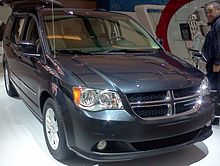
For the 2014 model year, three new packages were introduced: American Value Package (US), Canada Value Package (Canada), Blacktop package (US only), and the 30th Anniversary Edition. They are all different sets of SE and SXT trims and include new luxury features for the same price. The Grand Caravan AVP also gained easy-clean floor mats that came with the optional second-row Stow'n Go seats (standard on SE, SXT, and R/T).
The "Blacktop Package", based on SE and SXT, came equipped with 17-inch polished aluminum wheels with gloss black pockets, a gloss black grille, black headlamp bezels, an all-black interior including headliner, door panels and console, unique black cloth seats and door trim panels with silver accent stitching, a leather-wrapped steering wheel with silver accent stitching and a leather shift knob, choice of 6 body colors (Granite Crystal, Billet Silver, Brilliant Black, Maximum Steel, Redline Red, Bright White). SXT models also include fog lamps.
The "SE 30th Anniversary Edition", based on the SE trim, came equipped with 17-inch satin carbon aluminum wheels, body-color heated exterior mirrors, 30th Anniversary badging on the front fenders, silver accent stitching and piano black accents throughout, black cloth seats, a black leather-wrapped steering wheel, black leather-wrapped shift knob, black headliner and overhead console, bright heating and air conditioning trim bezels, power second- and third-row windows, and 30th Anniversary logo on the key fob
The "SXT 30th Anniversary Edition", based on the SXT trim, was packaged with 17-inch polished aluminum wheels with satin carbon pockets, bright chrome roof rack, bright window trim moldings, fog lamps, automatic headlamps, and special 30th Anniversary badging, Black Torino leatherette seats with premium suede inserts and silver accent stitching, power 10-way driver's seat, piano black accent trim bezels, and bright chrome accents throughout.
Both 30th Anniversary Editions included an available special body color, Granite Crystal Pearl Coat, a customized gauge cluster with 30th Anniversary badging, as well as the UConnect Handsfree Group (SiriusXM Satellite Radio with a one-year subscription, Bluetooth streaming audio and voice command and an auto-dimming rear view mirror). The vehicles arrived at dealerships at Q3 2013.
Also new for the 2014 model year, the Grand Caravan R/T gained standard auto headlamps with black bezels and the Security Group featuring remote start and security alarm.
2015 model year
The Grand Caravan was not changed for the 2015 model year except for content features added to SE Plus and SXT Plus trims. The SE Plus package included black leather upholstery, power windows for the second-row seats, and Chrysler's Uconnect voice command with Bluetooth sound system.
2016 model year
The new Chrysler Pacifica was unveiled on January 11, 2016, and getting all the attention, but the Dodge Grand Caravan continued to be marketed as a budget minivan alternative.
2017 model year
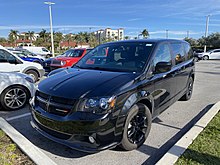
A small 2017 model year update was applied to SE, SE Plus, SXT, and GT (replacing the R/T) models. The 6.5-inch Touchscreen (Radio 430 and 430 NAV) became standard equipment with rear-view cameras on all models. (Navigation is standard on GT and optional on SXT.) The GT model also included monochromatic exterior and premium leather interior with red accent stitching
Sales of the Grand Caravan began in Mexico during this model year, positioned as the most accessible minivan in its class. Three models available in the Mexican market were SE, SXT and SXT Plus.
FCA unveiled the Chrysler Pacifica, a new minivan for the 2017 model year, at the 2016 North American International Auto Show. The Pacifica replaced the Chrysler Town & Country, but it was originally stated that the 2016 model of the Dodge Caravan would be produced for one more model year as a lower-cost alternative to the Pacifica, before being discontinued. In January 2017, FCA CEO Sergio Marchionne stated that it was not clear if the Caravan would be discontinued, and that they would have to look into offering "some level of affordable access to the Pacifica at the lower end to try and replace the outgoing models" (this would eventually come in the form of the sixth-generation Voyager, which was briefly produced alongside the RT Caravan). Despite the introduction of the higher-cost Pacifica model, sales of the Caravan increased by 26% in 2016. A substantial number of Caravans are sold to low-margin rental fleets. The vehicle continues to be positioned for price-conscious customers and it draws traffic to dealerships when the vehicle is aggressively priced. Additionally, FCA provided various rebates and incentives to assist purchases of the Grand Caravan and other models by customers with credit scores of less than 620.
According to a report by an automotive journalist, this strategy helps the Chrysler Pacifica hold its value better while also having a more affordable minivan available. Over 60% of the Dodge Caravan's sales goes to fleet sales and the vehicle was the second best selling vehicle for rental fleet sales.
2018 model year
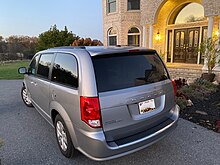
Production of Grand Caravans was temporarily suspended from September to November 2017 with the assembly of the 2018 model year versions starting in December 2017. The production line required changes to install airbags that meet U.S. Federal Motor Vehicle Safety Standard 226 calling for larger and more robust side-impact air curtains, as well as for them to deploy in the event of either a side-on collision or a rollover. Beginning with the 2018 models, changes included advanced multistage driver and front-passenger airbags that include low-risk deployment, a driver's-side inflatable knee blocker, front seat-mounted side airbags, and side-curtains for outboard passengers in all three rows.
For 2018, the Grand Caravan was Dodge's best-selling vehicle while the sales of foreign-branded minivans fared worse than the Dodge in 2018. Sales in Canada dropped 30 percent, significantly lower than in the previous six years.
2019 model year

The 2019 model year marked the 35th anniversary of the Chrysler minivans. A commemorative trim option was available on the SE and SXT models that included a bright grille, 17-inch "tech silver" aluminum wheels, a 35th Anniversary fender badge as well as "piano black" console and instrument panel accents and front floor mats with 35th Anniversary embroidered logo. A "Blacktop Package" featuring a black grille, headlamp bezels as well as an all-black interior was optional on SE and SXT 35th anniversary edition models.
The minivan market segment decreased in general. Sales of the Grand Caravan models in Canada declined by 9% during the first quarter of 2019, but it was still number 10 among the best-selling vehicles for that period in Canada. Most sales went to rental and fleet customers. The vehicle did not receive major changes, but continued to be produced because "Dodge sold more than 125,000 Grand Caravans last year , while Honda only sold 100,000 of its Odyssey minivans during the same year ."
The third shift at Windsor minivan plant ended in October 2019 due to sluggish sales, eliminating 1,500 direct jobs.
2020 model year
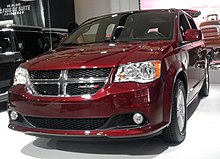
Three models were available: SE, SE Plus, and SXT. The Grand Caravan SE Plus model now included standard second-row Super Stow 'n Go bucket seats, a power eight-way driver seat, and an all-black interior with cranberry wine accent stitching on the seats. The optional "Blacktop Package" continued for the SE Plus and SXT models.
The Canadian market included six models starting from an entry-level version and then increasing the standard equipment on each: CVP, SXT, SXT Premium Plus, Crew, Crew Plus, and the GT which includes many convenience features as well as a performance suspension system and a monochromatic exterior. The "Blacktop Package" trim option is available on SXT models.
Trim levels for the Mexican market were unchanged from previous model years with SE, SXT and SXT Plus models available.
Safety
In the U.S. the National Highway Traffic Safety Administration's (NHTSA) New Car Assessment Program crash testing, the 2020 Dodge Grand Caravan achieved an overall four star rating.
| Frontal Impact – Driver and Passenger: | |
| Side Impact Driver: | |
| Side Impact Rear Passenger: | |
| Rollover: |
| Moderate overlap frontal offset | Good |
| Small overlap frontal offset | Poor |
| Side impact | Good |
| Roof strength (2012–present models) | Good |
Variants
Europe
Main article: Chrysler/Lancia Voyager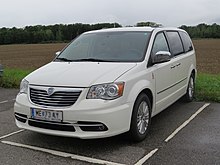
As with preceding generations, Chrysler marketed the Caravan in Europe as the Chrysler Voyager, with the fifth-generation becoming exclusively sold as the long-wheelbase Grand Voyager. From 2007 to June 2011, the model line was sold under the Chrysler brand; following the acquisition of Chrysler by Fiat, the Voyager was rebranded as a Lancia in continental Europe (with the Chrysler Voyager remaining in Ireland and the UK).
The Chrysler/Lancia Voyager was marketed under three trim lines distinct to Europe (Silver, Gold, and Platinum). The standard engine was a 2.8 L I4 diesel (producing 161 hp), with a 3.6 L gasoline V6 (producing 279 hp); both engines were paired to a 6-speed automatic.
Following the 2016 model year, exports of the Voyager were discontinued as Fiat Chrysler reorganized its brands, with Chrysler remaining largely in North America and Lancia sold exclusively in Italy.
Ram Cargo Van (Ram C/V Tradesman)
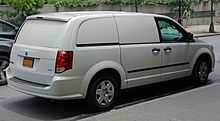
For the 2012 model year, the Ram Trucks division received the Dodge Grand Caravan C/V cargo van, renaming it the Ram Cargo (C/V) Tradesman (reviving the name used by Dodge for its full-size cargo vans during the 1970s). In contrast to its predecessor, the Tradesman was strictly a two-seat vehicle, with solid metal body paneling in place of rear windows and a flat rear load floor.
As the Ram brand increased its use of Fiat-based vehicles, the Tradesman was replaced for 2016 by the ProMaster City, an American-market version of the Fiat Doblò.
Volkswagen Routan
Main article: Volkswagen Routan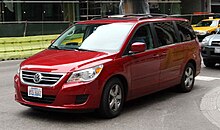
After a five-year hiatus, Volkswagen re-entered the minivan segment in North America by introducing the Volkswagen Routan for the 2009 model year. Replacing the Transporter T4 (1992, 1999–2003 EuroVan) in North America, the Routan was sold in the United States, Canada, and Mexico. Targeting approximately 5% of the sales within the minivan segment, Volkswagen entered into a 5-year production agreement with Chrysler.
The Routan was manufactured by Chrysler at its Windsor Assembly facility alongside the Grand Caravan and Town & Country, styled with its model-specific interior trim and front and rear exterior fascias. While sharing powertrains with the Grand Caravan, the Routan was given its own suspension tuning and seating configurations (the last Chrysler-designed minivans with lift-out seats). As part of the 2011 update of the Chrysler minivans, the Grand Caravan received the stiffer suspension tuning previously used by Volkswagen; while receiving the 3.6 L V6, the Routan carried over much of its interior.
Falling far under sales expectations, the final Routans were produced by Chrysler in August 2012; all 2013 sales were from dealer inventory, with 2014 vehicles sold exclusively to fleets. Originally predicting to sell 50,000 units per year, Volkswagen sold 57,683 Routans through its four years of production. As Volkswagen shifted to SUVs in North America, the Routan minivan was replaced for 2018 by the three-row Atlas (also replacing the Touareg in North America).
Discontinuation
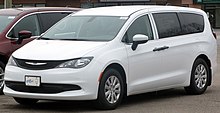
For 2017, Chrysler introduced its sixth-generation minivan, with the Chrysler Pacifica replacing the Chrysler Town & Country. Initially slated to end production following the 2016 model year, the Dodge Grand Caravan would live on through the 2020 model year. Although introduced in 2008, FCA marketed the model line below the Pacifica as the Dodge version continued fleet sales and its popularity in Canada.
After scheduling in February 2020 for production to end in May 2020, FCA later extended the date by three months to end assembly on August 22. In production for nearly 37 years (13 years as the fifth-generation RT platform), the final Dodge Grand Caravan rolled off the Windsor, Ontario, Canada assembly line on August 21, 2020.
Sixth generation 2021 + Canadian-market Grand Caravan
For 2021, Chrysler revived both the Voyager and Caravan nameplates under the Chrysler brand. Replacing entry-level trims of the Pacifica minivan, the Voyager is sold in the United States while the Grand Caravan is marketed in Canada. The two vehicles differed only in nameplates, but Chrysler retained the "Grand" extended-length prefix for the Grand Caravan (despite offering only a single length of minivans since 2008)
The 2022 Grand Caravan was no longer available in the lower SE model. The SXT incorporates the updated Uconnect 5 software for the 7-inch infotainment system with six speakers and active noise cancellation. Differences with the Pacifica include its standard 10.1-inch touchscreen and it is about 0.5 in (13 mm) longer than the Grand Caravan.
The 2023 model year the Chrysler Grand Caravan continued and available exclusively for Canada. It is a de-contented version of the U.S. version Pacifica and available in only the SXT trim.
The 2024 model year Chrysler Grand Caravan adds two new exterior colors, Baltic Grey and Red Hot.
Sales
| Calendar year | United States | Canada | Mexico | Total |
|---|---|---|---|---|
| 2002 | 244,911 | 244,911 | ||
| 2003 | 233,394 | 233,394 | ||
| 2004 | 242,307 | 63,559 | 305,866 | |
| 2005 | 226,771 | 65,002 | 291,773 | |
| 2006 | 211,140 | 61,901 | 273,041 | |
| 2007 | 176,150 | 55,041 | 231,191 | |
| 2008 | 123,749 | 39,396 | 163,145 | |
| 2009 | 90,666 | 40,283 | 130,949 | |
| 2010 | 103,323 | 55,306 | 158,629 | |
| 2011 | 110,862 | 53,406 | 164,268 | |
| 2012 | 141,468 | 51,552 | 193,020 | |
| 2013 | 124,019 | 46,732 | 170,751 | |
| 2014 | 134,152 | 51,759 | 185,911 | |
| 2015 | 97,141 | 46,927 | 144,068 | |
| 2016 | 127,678 | 51,513 | 496 | 179,191 |
| 2017 | 125,196 | 46,933 | 786 | 172,195 |
| 2018 | 151,927 | 32,266 | 1,732 | 185,925 |
| 2019 | 122,648 | 27,382 | 631 | 150,661 |
| 2020 | 38,765 | 22,884 | 227 | 54,756 |
| Subtotal | 2,824.137 | 807,334 | 3,872 | |
| Total Sales | 3,635.343 |
Notes
- Hyde, Charles K. (2003). Riding the Roller Coaster: a history of the Chrysler Corporation. Wayne State University Press. p. 267. ISBN 978-0-8143-3091-3. Retrieved June 20, 2022 – via Google Books.
- ^ Waddell, Dave (May 8, 2020). "950 Windsor Assembly workers return next week, demise of Caravan pushed back 3 months". Windsor Star. Ontario, Canada. Retrieved June 20, 2022.
- "FCA US Media – Family Famous: 2021 Chrysler Grand Caravan Available Exclusively for Canada". media.fcanorthamerica.com (Press release). July 16, 2020. Retrieved June 20, 2022.
- Bruce, Chris (February 8, 2019). "Chrysler And Dodge Minivans Get 35th Anniversary Editions". motor1.com. Retrieved September 8, 2020.
- ^ Zatz, David (November 16, 2020). "Creating the Plymouth, Dodge, and Chrysler Minivan: The Caravan/Voyager Development Story". allpar.com. Retrieved June 20, 2022.
- "Bob Hubbach". LinkedIn. Retrieved October 6, 2015.
- "YouTube". YouTube. Archived from the original on March 14, 2016.
- "United States Patent: D286865". Patft.uspto.gov. November 25, 1986. Archived from the original on October 18, 2015. Retrieved October 6, 2015.
- "1989 Dodge Caravan brochure". pp. 14–15. Archived from the original on May 30, 2018. Retrieved May 29, 2018.
- Dean, Sam (February 18, 2013). "The History of the Car Cup Holder". Bon Appetit. Retrieved January 13, 2019.
- Wade, Lisa (March 8, 2013). "When Did Cars Get Cup Holders?". The Society Pages. Retrieved September 8, 2020.
- Witzenburg, Gary (September 1983). "Detroit '84". Popular Mechanics. Vol. 160, no. 3. p. 162. ISSN 0032-4558. Retrieved September 8, 2020.
- ^ "Chrysler, Plymouth, and Dodge four-speed automatic transmission repairs". allpar.com. November 16, 2020. Retrieved June 20, 2022.
- Eisenstein, Paul A. (July 29, 1990). "Car Changeovers Show Japan Lead". Chicago Tribune.
- "Bob Hubbach". LinkedIn. Retrieved October 6, 2015.
- ^ "1991-1995 Dodge Caravan, Plymouth Voyager minivans". allpar.com. November 16, 2020. Retrieved June 20, 2022.
- ^ "1994 minivans: Dodge Caravan, Plymouth Voyager, Chrysler Town & Country". allpar.com. November 16, 2020. Retrieved June 20, 2022.
- Hyde, Charles K. (2003). Riding the Roller Coaster: A History of the Chrysler Corporation. Wayne State University Press. p. 300. ISBN 978-0-8143-3091-3. Retrieved January 15, 2018.
- "Civil Action File No. 0110133833" (PDF). Archived from the original (PDF) on October 16, 2013. Retrieved May 11, 2014.
- DeMuro, Doug (November 2016). "Why Did It Take Minivans a Decade to Get Dual Sliding Doors?". autotrader.com. Retrieved November 28, 2019. Note: the Honda Odyssey had introduced the first four-door non-compact minivan for the United States & Canada in 1994, but the first-generation Odyssey had conventional hinged rear doors.
- Strohl, Daniel. ""These nine EVs from the 1990s set the stage for every one of today's electric vehicles"". Hemmings.com. American City Business Journals. Retrieved January 14, 2024.
- "Who's Where: Chrysler's new Design VPs". Car Design News. May 25, 2007. Archived from the original on April 2, 2015.
- "DaimlerChrysler Debuts minivans". Retrieved May 9, 2012.
- "Article: New Mini Oreos Debut in New Mini Van". AccessMyLibrary. August 10, 2000. Archived from the original on May 30, 2010. Retrieved September 26, 2009.
- "Article: The First, All-New 2001 Chrysler Town and Country and 2001 Dodge Caravan..." AccessMyLibrary. July 19, 2000. Archived from the original on September 2, 2019. Retrieved September 26, 2009.
- "Stellantis Media – Windsor Assembly Plant". media.stellantisnorthamerica.com. Retrieved December 27, 2021.
- "Home page". Chrysler China. Archived from the original on November 25, 2020. Retrieved May 11, 2014.
- ^ "Chrysler extends leadership in Mideast minivan segment with 'Stow 'n Go'". Ameinfo.com. February 12, 2005. Archived from the original on March 25, 2013. Retrieved May 11, 2014.
- ^ "Chrysler Group Brings Minivan Segment's Only Stow 'n Go Seating And Storage System to Market in Just 18 Months" (Press release). PRnewswire – Chrysler Group. January 5, 2004. Retrieved March 26, 2016.
- "Stow 'N Go Seating and Storage System Solidifies Dodge Caravan as the Leader in Minivan Sales and Innovations" (Press release). Chrysler Group. Retrieved May 11, 2014.
- "Stow 'n Go Minivan Technology Awarded Popular Science Magazine's "Best of What's New" for 2005". Autointell.com. November 10, 2004. Retrieved May 11, 2014.
- McIntosh, Jil (February 25, 2008). "Test Drive: 2008 Dodge Grand Caravan Canada "Value Package"". Autos Canada. Retrieved May 11, 2014.
- ^ Durbin, Dee-Ann (June 6, 2008). "Minivan sales slow, hit by gas prices and image". USA Today. Retrieved May 11, 2014.
- "Iihs-Hldi". Iihs.org. Archived from the original on April 7, 2010. Retrieved April 3, 2010.
- "High fleet sales rates take toll". Automotive News. November 15, 2010. Retrieved May 11, 2014.
- Szymkowski, Sean (February 28, 2020). "Dodge Grand Caravan, a soccer mom icon, officially dies this year". CNET. Retrieved June 20, 2022.
- "FCA dealers rue end of low-cost Dodge Grand Caravan". Automotive News Canada. July 8, 2020. Retrieved September 8, 2020.
- "Chrysler Pentastars Engines – Specifications". allpar.com. Retrieved June 20, 2022.
- Jackson, Bill. "2009 Dodge Grand Caravan Specs, Price, MPG, & Reviews". cars.com. Retrieved November 12, 2019.
- "2010 Dodge Grand Caravan Pricing, Reviews & Ratings". Kelly Blue Book. Retrieved November 12, 2019.
- "2011 Chrysler Town & Country and 2011 Dodge Caravan Minivans". allpar.com. November 16, 2020. Retrieved June 20, 2022.
- "2011 Dodge Grand Caravan Crew Startup, Engine, Test Drive and In Depth Tour". youtube.com. May 17, 2011. Retrieved November 11, 2023.
- "2013 Dodge Grand Caravan Reviews and Model Information". Auto Trader. Retrieved November 12, 2019.
- "2014 Dodge Grand Caravan Celebrates Its 30th Birthday With Even More Desirable Content and Value" (Press release). Chrysler. Retrieved May 11, 2014.
- "Dodge Grand Caravan and Chrysler Town & Country receive 30th Anniversary Editions". Worldcarfans.com. September 3, 2013. Retrieved May 11, 2014.
- Sessions, Ron (September 1, 2013). "Chrysler Group Celebrates 30 Years of Minivans with 30th Anniversary Edition Grand Caravan and Town & Country". Blog.caranddriver.com. Archived from the original on September 25, 2017. Retrieved May 11, 2014.
- "2016 Dodge Grand Caravan: New Car Review". autotrader.com. Retrieved November 12, 2019.
- "2017 Dodge Grand Caravan". Cars.com. Archived from the original on November 12, 2019.
- "2017 Dodge Grand Caravan Technology".
- "2017 Dodge Grand Caravan Fact Sheet". Stellantis. Retrieved February 14, 2021.
- Ponce, Esaú (January 23, 2017). "Dodge Grand Caravan 2017 llega a México desde $469,900 pesos". Autocosmos. Retrieved September 24, 2020.
- Vargas, Eduardo (January 23, 2017). "Llega a México Dodge Grand Caravan 2017". Revista Transportes y Turismo. Retrieved September 24, 2020.
- Priddle, Alisa (December 5, 2015). "2017 Chrysler minivan coming; Dodge not leaving yet". Detroit Free Press. Retrieved March 26, 2016.
- Wayland, Michael (January 11, 2016). "2017 Chrysler Pacifica: All-new 'modern family' minivan". The Detroit News. Retrieved March 26, 2016.
- Vellequette, Larry P. (June 22, 2015). "Dodge plans to produce '17 minivan". Automotive News. Retrieved March 26, 2016.
- ^ Vellequette, Larry P. (January 16, 2017). "As Pacifica ramps up, Grand Caravan lives on". Automotive News. Retrieved June 4, 2017.
- ^ Guilford, Dave (October 22, 2018). "In with the new (but keep the old)". Retrieved October 24, 2019.
- "Sales flatten; Nissan's big rental bet". Kelley Blue Book. Retrieved November 14, 2019.
- ^ Hughes, Justin (June 23, 2017). "Dodge Grand Caravan Continues Through 2019, But Delayed for U.S." The Drive. Retrieved November 11, 2019.
- Colias, Mike. "Nissan Makes Unconventional Bet on Rental-Car Market to Boost U.S. Sales". WSJ. Retrieved November 14, 2019.
- "Chrysler Cars (Build Out Final Order Start Up Dates)". Donlen. May 12, 2017. Retrieved June 4, 2017.
- "FCA Sets 2018-MY Order Dates". Automotive Fleet. February 28, 2017. Retrieved June 4, 2017.
- Layson, Greg (September 14, 2017). "FCA to halt minivan output 5 weeks over U.S. airbag law". Automotive News. Retrieved November 11, 2017.
- "2018 Dodge /// Durango /// Journey /// Grand Caravan" (PDF). dodge.com. p. 38. Retrieved September 8, 2020.
- ^ Willems, Steph (December 13, 2018). "As Plant Preps for Downtime, America's Grand Caravan Love Appears Unshakeable". The Truth About Cars. Retrieved October 24, 2019.
- "Minivans Celebrate 35th Anniversary with Special Edition Models". FCA Group (Press release). February 11, 2019. Retrieved October 24, 2019.
- ^ "2019 Dodge Grand Caravan Fact Sheet". FCA US. September 1, 2018. Retrieved October 24, 2019.
- ^ Cain, Timothy (April 11, 2019). "Canada's 10 best-selling vehicles in the first quarter of 2019". Driving Canada. Retrieved November 11, 2019.
- "2019 Dodge Grand Caravan Review". autotrader.com. Retrieved November 12, 2019.
- Irwin, John (June 26, 2019). "FCA extends Windsor minivan plant's third shift by 3 weeks for fleet order". Automotive News Canada. Retrieved July 11, 2019.
- "2020 Dodge Grand Caravan Fact Sheet". FCA US. September 1, 2019. Retrieved October 24, 2019.
- "FCA Canada: 2020 Dodge Grand Caravan Fact Sheet" (Press release). FCA Canada. September 1, 2019. Retrieved October 24, 2019.
- "Dodge Grand Caravan 2020 – Dodge México". FCA México. Retrieved September 24, 2020.
- "2020 Dodge Grand Caravan MV FWD". NHTSA. Retrieved September 8, 2020.
- "2015 Dodge Grand Caravan". Iihs.org. 2015. Archived from the original on October 6, 2015. Retrieved October 5, 2015.
- "New Lancia Grand Voyager Minivan is a Rebadged Chrysler, and Yes, this Picture Too Appears to be a Chop". Carscoop. February 14, 2011. Archived from the original on March 18, 2012. Retrieved May 11, 2014.
- "Ram C/V Tradesman Official Site". Ram Trucks.
- ^ Brown, Jacob (March 29, 2013). "Not-Surprising News: Volkswagen Discontinuing Routan Minivan Sales". Automotive.com. Archived from the original on February 3, 2014. Retrieved April 4, 2016.
- Holmes, Jake (December 12, 2012). "Report: Volkswagen Routan Minivan Production Halted Temporarily". Automobile magazine. Retrieved April 4, 2016.
- "2011 Volkswagen Routan minivan car review". November 16, 2020. Retrieved June 20, 2022.
- Healey, James (March 18, 2011). "Volkswagen's Routan has some smooth hustle". USAToday. Retrieved April 4, 2016.
- ^ "Volkswagen Routan dead one last time". Autoblog. Retrieved October 22, 2019.
- DeMuro, Doug (April 2013). "2013 VW Routan Canceled". Autotrader. Retrieved October 24, 2019.
- Duffer, Robert (December 10, 2015). "Discontinued car models for 2016". Chicago Tribune. Retrieved July 26, 2020.
- Beresford, Colin (February 28, 2020). "Dodge Grand Caravan Production Coming to an End". Car and Driver. Retrieved February 28, 2020.
- Borrelli, Melanie (August 21, 2020). "Last Dodge Grand Caravan rolls off the line at Windsor Assembly Plant". Windsor CTVN News. Retrieved August 22, 2020.
- Butler, Zach (July 24, 2019). "Report: The Grand Caravan Will Soon Meet Its End, Thanks To The Chrysler Voyager". The Fast Lane Car. Retrieved July 26, 2020.
- "Grand Caravan nameplate lives on in Canada, shifts to Chrysler brand for 2021". Driving Canada. July 16, 2020. Retrieved July 16, 2020.
- "The New 2021 Chrysler Grand Caravan". Chrysler Canada (Press release). Retrieved July 16, 2020.
- "FCA US Media – Family Famous: 2021 Chrysler Grand Caravan Available Exclusively for Canada". FCA US Media (Press release). Retrieved July 16, 2020.
- Miller, Robert S. (October 17, 2021). "Everything You Need To Know About The 2022 Chrysler Grand Caravan!". MoparInsiders. Retrieved November 2, 2023.
- "2022 Chrysler Pacifica vs. 2022 Chrysler Grand Caravan Differences". Finch Chrysler. January 12, 2022. Retrieved November 2, 2023.
- "Stellantis Media - Canada: 2023 Chrysler Grand Caravan Fact Sheet". media.stellantisnorthamerica (Press release). September 1, 2022. Retrieved November 2, 2023.
- Bleakney, Peter. "2023 Chrysler Grand Caravan Overview". Driving Canada. Retrieved November 2, 2023.
- "Stellantis Media - Canada: 2024 Chrysler Grand Caravan Fact Sheet". media.stellantisnorthamerica. September 1, 2023. Retrieved November 2, 2023.
- "Dodge Grand Caravan Sales Figures". GCBC.
- "December 2008 Sales: Chrysler LLC". CheersandGears.com. January 5, 2009. Retrieved January 5, 2009.
- "Chrysler Canada Announces 2008 Calendar Year Sales Results" (Press release). Chrysler Canada. January 5, 2009. Retrieved May 11, 2014.
- "Chrysler Group LLC December 2009 Sales". CheersandGears.com. January 5, 2010. Retrieved January 5, 2010.
- ^ "Chrysler Canada Celebrates 26 Per Cent Sales Growth in 2010" (Press release). Chrysler Canada. January 4, 2011. Retrieved May 11, 2014.
- "Chrysler Group LLC December 2010 Sales". CheersandGears.com. January 4, 2011. Retrieved January 4, 2011.
- "Chrysler sales shoot up 37% (26% for 2011)". allpar.com. March 17, 2017. Retrieved June 20, 2022.
- ^ "Dodge Grand Caravan Sales Figures". goodcarbadcar.net. Retrieved November 11, 2014.
- "Chrysler Group LLC Reports December 2012 U.S. Sales Increased 10 Percent" (Press release). Chrysler Group. January 3, 2013. Retrieved May 11, 2014.
- "Chrysler Canada Finishes Year With Best Retail Sales Year Since 2000" (Press release). Chrysler Canada. Retrieved May 11, 2014.
- "Chrysler Group LLC Reports December 2013 U.S. Sales Increased 6 Percent" (Press release). Chrysler Group. January 3, 2014. Retrieved January 6, 2014.
- "FCA US LLC Reports December 2014 U.S. Sales Increased 20 Percent – Best December Sales in a Decade; Full-Year Sales Up 16 Percent – Strongest Annual Sales Since 2006". prnewswire.com (Press release). January 5, 2015. Retrieved October 5, 2015.
- "FCA US LLC Reports December 2015 U.S. Sales Increased 13 Percent" (PDF) (Press release). FCA US. January 5, 2016. Archived from the original (PDF) on January 8, 2016. Retrieved January 7, 2016.
- "NAFTA – FCA Group". fcanorthamerica.com. Archived from the original on January 5, 2017. Retrieved May 9, 2017.
- "NAFTA – FCA Group". fcanorthamerica.com. Archived from the original on August 25, 2017. Retrieved May 9, 2017.
- "Stellantis Media – FCA US Reports 2018 December and Full-Year Sales".
- "Stellantis Media – FCA Canada Reports December and Full Year Sales Record for Jeep® Wrangler".
- Autocosmos (August 22, 2017). "Los 5 modelos más vendidos de cada segmento en julio 2017". noticias.autocosmos.com.mx.
- "FCA US Reports 2018 December and Full-Year Sales". prnewswire.com (Press release). January 3, 2019. Retrieved October 24, 2019.
- "FCA Canada Reports Fourth-quarter and Full-year Sales" (Press release). Stellantis Media. January 3, 2020. Retrieved February 2, 2021.
- Inegi (Datos Primarios)
- "FCA Canada Reports Fourth-quarter and Full-year Sales" (Press release). FCA Canada. January 3, 2020. Retrieved January 18, 2020.
- Cain, Timothy. "Dodge Grand Caravan Sales Figures". GCBC. Retrieved February 2, 2021.
External links
| Dodge | |||||||||||||||||||||||||||||||
|---|---|---|---|---|---|---|---|---|---|---|---|---|---|---|---|---|---|---|---|---|---|---|---|---|---|---|---|---|---|---|---|
| Established in 1900, a division of Chrysler since 1928 | |||||||||||||||||||||||||||||||
| Current models |
| ||||||||||||||||||||||||||||||
| Former models (by date of introduction) |
| ||||||||||||||||||||||||||||||
| Related topics | |||||||||||||||||||||||||||||||
|
Rebadged models, mostly from Japanese, Korean or Chinese manufacturers – Rebadged Chrysler/Plymouth models for external markets | |||||||||||||||||||||||||||||||
| Dodge truck timeline, North American market, 1970s–present | |||||||||||||||||||||||||||||||||||||||||||||||||||||||||||||||||||||||||||||||||||||||||||||||||||||||||||||||||||||||||||||||||||||||||||||||||||||||||||||||||||||||||||||||||||||||||||||||||||||||||||||||||||||||||||||||||||||||||||||||||||||||||||||||||||||||||||||||||||||||||||||||||||||||||||||||||||||||||||||||||||||||||||||||||||||||||||||||||||||||||||||||||||||||||||||||||||||||||||||||||||||||||||||||||||||||||||||||||||||||||||||||||||||||||||||||||||||||||||||||||||||||||||||||||||||||||||||||||||||||||||||||||||||||||||||||||||||||||||||||||||||||||||||||||||||||||||||||||||||||||||||||||||||||||||||||||||||||||||||||||||||||||||||||||||||||||||||||||||||||||||||||||||||||||||||||||||||||||||||||||||||||||||||||||||||||||||||||||||||||||||||||||||||||||||||||||||||||||||||||||||||||||||||||||||||||||||||||||||||||||||||||||||||||||||||||||||||||||||||||||||||||||||||||||||||||||||||||||||||||||||||||||||||||||||
|---|---|---|---|---|---|---|---|---|---|---|---|---|---|---|---|---|---|---|---|---|---|---|---|---|---|---|---|---|---|---|---|---|---|---|---|---|---|---|---|---|---|---|---|---|---|---|---|---|---|---|---|---|---|---|---|---|---|---|---|---|---|---|---|---|---|---|---|---|---|---|---|---|---|---|---|---|---|---|---|---|---|---|---|---|---|---|---|---|---|---|---|---|---|---|---|---|---|---|---|---|---|---|---|---|---|---|---|---|---|---|---|---|---|---|---|---|---|---|---|---|---|---|---|---|---|---|---|---|---|---|---|---|---|---|---|---|---|---|---|---|---|---|---|---|---|---|---|---|---|---|---|---|---|---|---|---|---|---|---|---|---|---|---|---|---|---|---|---|---|---|---|---|---|---|---|---|---|---|---|---|---|---|---|---|---|---|---|---|---|---|---|---|---|---|---|---|---|---|---|---|---|---|---|---|---|---|---|---|---|---|---|---|---|---|---|---|---|---|---|---|---|---|---|---|---|---|---|---|---|---|---|---|---|---|---|---|---|---|---|---|---|---|---|---|---|---|---|---|---|---|---|---|---|---|---|---|---|---|---|---|---|---|---|---|---|---|---|---|---|---|---|---|---|---|---|---|---|---|---|---|---|---|---|---|---|---|---|---|---|---|---|---|---|---|---|---|---|---|---|---|---|---|---|---|---|---|---|---|---|---|---|---|---|---|---|---|---|---|---|---|---|---|---|---|---|---|---|---|---|---|---|---|---|---|---|---|---|---|---|---|---|---|---|---|---|---|---|---|---|---|---|---|---|---|---|---|---|---|---|---|---|---|---|---|---|---|---|---|---|---|---|---|---|---|---|---|---|---|---|---|---|---|---|---|---|---|---|---|---|---|---|---|---|---|---|---|---|---|---|---|---|---|---|---|---|---|---|---|---|---|---|---|---|---|---|---|---|---|---|---|---|---|---|---|---|---|---|---|---|---|---|---|---|---|---|---|---|---|---|---|---|---|---|---|---|---|---|---|---|---|---|---|---|---|---|---|---|---|---|---|---|---|---|---|---|---|---|---|---|---|---|---|---|---|---|---|---|---|---|---|---|---|---|---|---|---|---|---|---|---|---|---|---|---|---|---|---|---|---|---|---|---|---|---|---|---|---|---|---|---|---|---|---|---|---|---|---|---|---|---|---|---|---|---|---|---|---|---|---|---|---|---|---|---|---|---|---|---|---|---|---|---|---|---|---|---|---|---|---|---|---|---|---|---|---|---|---|---|---|---|---|---|---|---|---|---|---|---|---|---|---|---|---|---|---|---|---|---|---|---|---|---|---|---|---|---|---|---|---|---|---|---|---|---|---|---|---|---|---|---|---|---|---|---|---|---|---|---|---|---|---|---|---|---|---|---|---|---|---|---|---|---|---|---|---|---|---|---|---|---|---|---|---|---|---|---|---|---|---|---|---|---|---|---|---|---|---|---|---|---|---|---|---|---|---|---|---|---|---|---|---|---|---|---|---|---|---|---|---|---|---|---|---|---|---|---|---|---|---|---|---|---|---|---|---|---|---|---|---|---|---|---|---|---|---|---|---|---|---|---|---|---|---|---|---|---|---|---|---|---|---|---|---|---|---|---|---|---|---|---|---|---|---|---|---|---|---|---|---|---|---|---|---|---|---|---|---|---|---|---|---|---|---|---|---|---|---|---|---|---|---|---|---|---|---|---|---|---|---|---|---|---|---|---|---|---|---|---|---|---|---|---|---|---|---|---|---|---|---|---|---|---|---|---|---|---|---|---|---|---|---|---|---|---|---|---|---|---|---|---|---|---|---|---|---|---|---|---|---|---|---|---|---|---|---|---|---|---|---|---|---|---|---|---|---|---|---|---|---|---|---|---|---|---|---|---|---|---|---|---|---|---|---|---|---|---|---|---|---|---|---|---|---|---|---|---|---|---|---|---|---|---|---|---|---|---|---|---|---|---|---|---|---|---|---|---|---|---|---|---|---|---|---|---|---|---|---|---|---|---|---|---|---|---|---|---|---|---|---|---|---|---|---|---|---|---|---|---|---|---|---|---|---|---|---|---|---|---|---|---|---|---|---|---|---|---|---|---|---|---|---|---|---|---|---|---|---|---|---|
| |||||||||||||||||||||||||||||||||||||||||||||||||||||||||||||||||||||||||||||||||||||||||||||||||||||||||||||||||||||||||||||||||||||||||||||||||||||||||||||||||||||||||||||||||||||||||||||||||||||||||||||||||||||||||||||||||||||||||||||||||||||||||||||||||||||||||||||||||||||||||||||||||||||||||||||||||||||||||||||||||||||||||||||||||||||||||||||||||||||||||||||||||||||||||||||||||||||||||||||||||||||||||||||||||||||||||||||||||||||||||||||||||||||||||||||||||||||||||||||||||||||||||||||||||||||||||||||||||||||||||||||||||||||||||||||||||||||||||||||||||||||||||||||||||||||||||||||||||||||||||||||||||||||||||||||||||||||||||||||||||||||||||||||||||||||||||||||||||||||||||||||||||||||||||||||||||||||||||||||||||||||||||||||||||||||||||||||||||||||||||||||||||||||||||||||||||||||||||||||||||||||||||||||||||||||||||||||||||||||||||||||||||||||||||||||||||||||||||||||||||||||||||||||||||||||||||||||||||||||||||||||||||||||||||||
| Ram Trucks | |||||||
|---|---|---|---|---|---|---|---|
| A marque of Stellantis | |||||||
| Trucks |
| ||||||
| Vans |
| ||||||
| « Dodge—Ram truck timeline, North American market, 2010–present | |||||||||||||||||||||||||||||||||||||||||||||||||||||||||||||||||||||||||||||||||||||||||||||||||||||||||||||||||||||||||||||||||||||||||||||||||||||||||||||||||||||||||||||||||||||||||||||||||||||||||||||||||||||||||||||||||||||||||||||
|---|---|---|---|---|---|---|---|---|---|---|---|---|---|---|---|---|---|---|---|---|---|---|---|---|---|---|---|---|---|---|---|---|---|---|---|---|---|---|---|---|---|---|---|---|---|---|---|---|---|---|---|---|---|---|---|---|---|---|---|---|---|---|---|---|---|---|---|---|---|---|---|---|---|---|---|---|---|---|---|---|---|---|---|---|---|---|---|---|---|---|---|---|---|---|---|---|---|---|---|---|---|---|---|---|---|---|---|---|---|---|---|---|---|---|---|---|---|---|---|---|---|---|---|---|---|---|---|---|---|---|---|---|---|---|---|---|---|---|---|---|---|---|---|---|---|---|---|---|---|---|---|---|---|---|---|---|---|---|---|---|---|---|---|---|---|---|---|---|---|---|---|---|---|---|---|---|---|---|---|---|---|---|---|---|---|---|---|---|---|---|---|---|---|---|---|---|---|---|---|---|---|---|---|---|---|---|---|---|---|---|---|---|---|---|---|---|---|---|---|---|---|---|---|---|---|---|---|---|---|---|---|---|---|---|---|---|---|
| |||||||||||||||||||||||||||||||||||||||||||||||||||||||||||||||||||||||||||||||||||||||||||||||||||||||||||||||||||||||||||||||||||||||||||||||||||||||||||||||||||||||||||||||||||||||||||||||||||||||||||||||||||||||||||||||||||||||||||||
Categories: